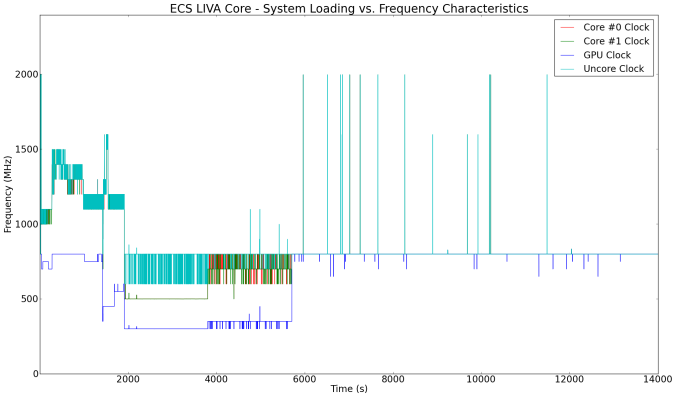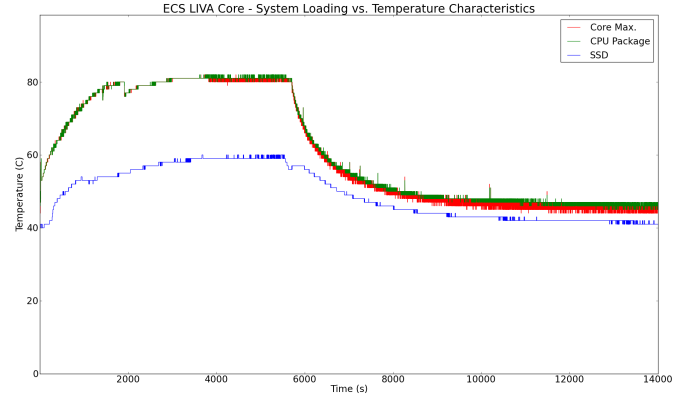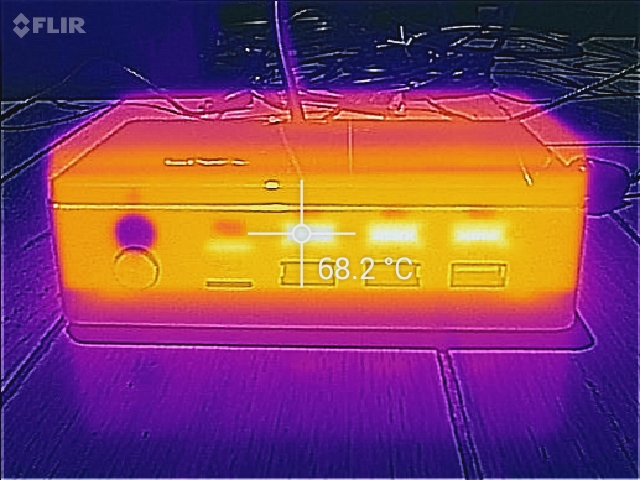ECS LIVA Core Review: A Fanless Core M mini-PC
by Ganesh T S on October 7, 2015 8:00 AM ESTPower Consumption and Thermal Performance
The power consumption at the wall was measured with a 1080p display being driven through one of the HDMI ports. In the graphs below, we compare the idle and load power of the ECS LIVA Core with other low power PCs evaluated before. For load power consumption, we ran Furmark 1.12.0 and Prime95 v27.9 together. In terms of idle power, only the ECS LIVA x2 with an Atom-class SoC platform is better.


On the full load side, we observed 17.44 W peak power consumption. However, this was in the turbo mode for less than 15 seconds. In the full load steady state, we observed the power consumption to be around 10.1 W - the lowest of any mini-PC that we have evaluated so far.
Our thermal stress routine starts with the system at idle, followed by 30 minutes of pure CPU loading. This is followed by another 30 minutes of both CPU and GPU being loaded simultaneously. After this, the CPU load gets removed, allowing the GPU to be loaded alone for another 30 minutes. The various clocks in the system as well as the temperatures within the unit are presented below. In the first graph, we can see the small spike to 2 GHz for the core clocks very early on in the evaluation routine. The cores drop down to 1 GHz, but later on move to 1.5 GHz for a while before settling down around 1.2 GHz. However, introduction of additional GPU load forces the cores to operate between 600 and 800 MHz, while the GPU staus at 300 MHz. Removal of the CPU load allows the GPU to go up to 350 MHz under sustained loading conditions.
According to the official specifications, the junction temperature of the Core M 5Y10c is 95 C. The maximum core temperature recorded in the course of our thermal evaluation routine was only around 80 C - indicating that the thermal solution is good enough for the platform.
Another important aspect to keep note of while evaluating fanless PCs is the chassis temperature. Using the Android version of the FLIR One thermal imager, we observed the chassis temperature after the CPU package temperature reached the steady state value in the above graph.
We have additional thermal images in the gallery below.
A chassis temperature of around 68 C is definitely a bit too hot to handle, but, thankfully, it is not as bad as the 75 C we saw in the LIVA X2. The metal base at the bottom as well as the substantially better heat sink on top of the SoC manage to keep the temperature of the system under better limits. However, the chassis design could definitely do with some improvements to make this aspect better.



















35 Comments
View All Comments
cjb110 - Thursday, October 8, 2015 - link
It's probably a side effect of them being soldered on the board, they've counted 4 of chips, each being 8 gigabit. If it had used sticks, then I doubt they'd have been counted as such. Some GPU reviews have done the same.GatesDA - Wednesday, October 7, 2015 - link
It's weird, but the lower-case "b" matters. For some reason it's listed in gigabits, and 8 gigabits (Gb) = 1 gigabyte (GB).mctylr - Wednesday, October 7, 2015 - link
No, it's not weird if you are use to using SI (metric), where prefixes are case sensitive as well (i.e. Mega versus milli).frenchy_2001 - Wednesday, October 7, 2015 - link
And if you want to be pedantic, they are NOT using the right symbol either.It should be 4 x 8Gib = 4 GiB
Gi = 2^30
G = 10 ^9, SI notation
http://wintelguy.com/gb2gib.html
mkozakewich - Thursday, October 8, 2015 - link
Yeah, but that's stupid anyway. Only drive manufacturers use base-10 units. We should just call a billion byes "drive gigabytes" and leave the rest as regular GB.piroroadkill - Thursday, October 8, 2015 - link
Disagree, there are actual standards on this kind of thing.Drive units are using correct SI order of magnitude prefix notation, whereas RAM manufacturers are not, and most people do not use them correctly. Windows reports sizes incorrectly (using the traditional, incorrect method). OS X reports sizes using SI notation these days, correctly.
Vepsa - Wednesday, October 7, 2015 - link
I think this would be great for a LSTP thin client.bznotins - Wednesday, October 7, 2015 - link
Feels like no hardware H.265 support is a deal-killer.Looking-forward to the lower-power Skylake CPUs for future streaming boxes.
nathanddrews - Thursday, October 8, 2015 - link
That's my thought as well. Looking at it purely from a HTPC perspective, without HEVC support, it really offer very little over a much cheaper Atom-based Liva. As a generic workstation, you can't upgrade the RAM and the SSD upgrade path is very limited. It lacks a second gigabit port, so you can't make a router out of it either. For gaming, it's worthless unless you use it as a streamer, but then you can do that with much cheaper units as well. For $450-500, it's a terrible purchase no matter what your end goal is.Meh.
Oxford Guy - Thursday, October 8, 2015 - link
"The only unfortunate aspect here is the complete absence of any sort of hardware acceleration for HEVC."It strikes me as particularly ridiculous that Intel has rolled out their 14nm parts with iGPUs that have no H.265. WEAK.